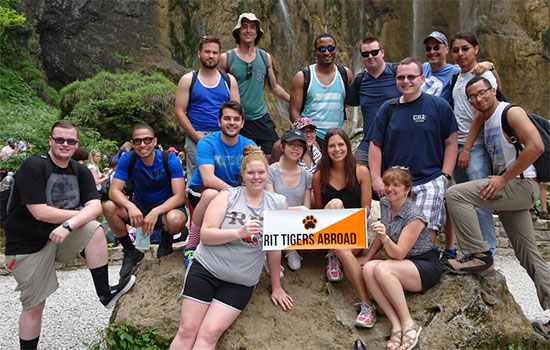Civil Engineering Technology goes abroad
More than sixty civil engineering technology students have participated in study abroad programs since 2010. While some students have independently coordinated full semester and/or summer global experiences to Australia, Japan and European countries, most students participate in department-organized study abroad programs in Croatia and Ireland.
Croatia is our most common destination. RIT has campuses in both the small coastal city of Dubrovnik as well as the capital city of Zagreb. Zagreb is a bustling Central European-style city with modern architecture, winding cobblestone streets, and old city neighborhoods. The city boasts more than 20 museums, along with a variety of art galleries, cafes, and stylish boutiques. We’ve developed study abroad programs to Zagreb that provide technical instruction with geographical information systems or Revit, state-of-the-practice architectural software. Students have plenty of time during the week to explore Zagreb and absorb Croatian cuisine and culture. They also have two three-day weekends to independently plan trips to places like Venice, Vienna, Dubrovnik, Budapest, Munich, Salzburg, Zurich, and the Dalmatian coast.
In May 2014, civil engineering technology faculty, in collaboration with our colleagues in the civil engineering program at Dublin Institute of Technology (DIT), created Transatlantic Capstone. This very unique global education program forms international design teams of two DIT students and two RIT students. The teams meet the requirements of either RIT’s CVET Capstone course or DIT’s Design Project course. Students communicate; distribute work assignments; develop solutions; share, review, comment, revise, present work products; and assess performance through a variety of web-based options including email, Skype, Google Docs, etc. While travel is not a requirement of transatlantic capstone, students from DIT and RIT travel to their partner’s university most years to work face-to-face on their projects and/or present their final design.
Rochester and Dublin students work closely on a civil engineering project. They witness the differences and similarities of day-to-day issues that college students experience, such as group work, professors, assignments, jobs, activities, friends, and family. Technically, the students learn about the similarities and differences in design procedures, policies, regulations, and guidance documents between the U.S. and European Union. Here are two samples of students’ reflections on Transatlantic Capstone:
“Learning how engineering processes work in another country and working with individuals of diverse background helped our project be stronger, but also I personally learned a great deal about my group members and their cultures. It was a truly multi-cultural experience that I absolutely loved. Everyone's different background meant that we all approached the task at-hand slightly differently, which allowed us to discuss and collaborate together. I believe this resulted in a quality project. We also got to learn all about the history of Ireland and see some phenomenal sights while we were over there. Overall, a wonderful educational and cultural experience!”
“A large resume booster. I spoke about the project a lot in interviews. This will also help learning how to communicate better at work through online meetings.”









